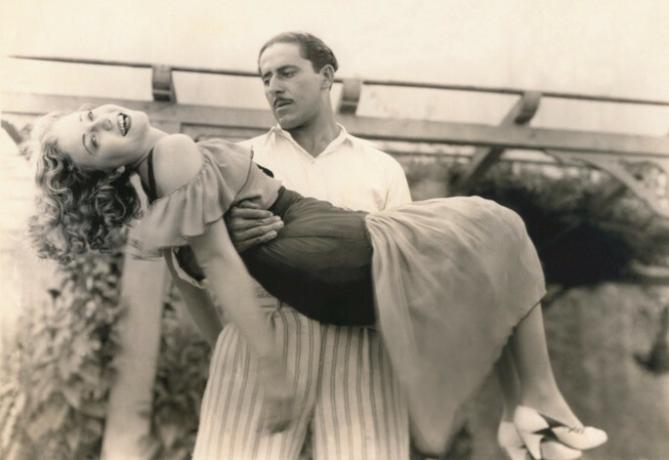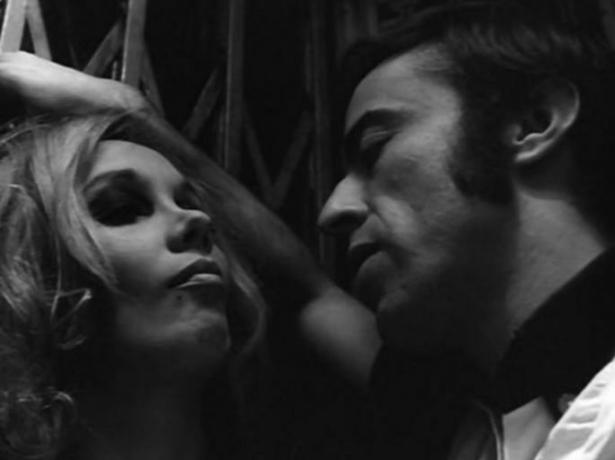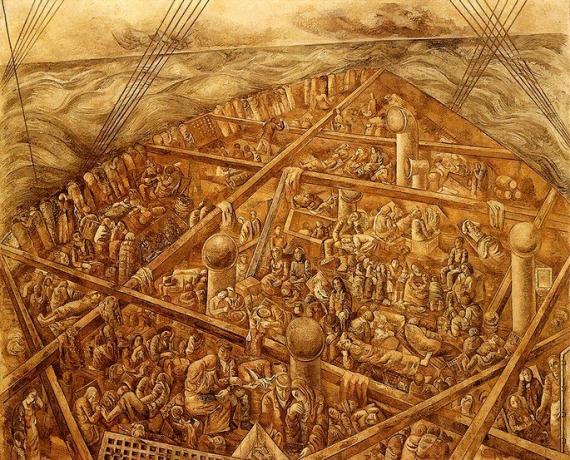THE history of cinema in Brazil it begins in July 1896, when the country's first movie screening takes place, in the city of Rio de Janeiro.
In the world, cinema began in December 1895, in the city of Paris. The film shown was Exit of Workers from the Lumière Factory, of the Lumiére brothers.
Initially, cinema was silent, and it was only in the 1930s that spoken cinema appeared.

Summary of the History of Cinema in Brazil
In 1887, after the country's cinematographic debut, the first movie theater opened to the public in the capital of Rio de Janeiro was created, at the urging of the Italian brothers Paschoal Segreto and Affonso Segreto.
They were the pioneers of cinema in Brazil, considered the first filmmakers in the country, since they made recordings in the Baía de Guanabara, in 1898.
The following year, Pachoal Segreto filmed in the city of São Paulo during the celebration of the unification of Italy.
However, it was only at the beginning of the 20th century that São Paulo had its first movie theater, called Bijou Theatre.

One of the initial problems of cinema production in the country was the lack of electricity, which was only resolved in 1907 with the installation of the Ribeirão de Lages Plant, in Rio de Janeiro.
After this event, the number of rooms grew considerably in the city of Rio de Janeiro, reaching around 20 exhibition rooms.
Twentieth Century and the Expansion of Cinema in Brazil
In the beginning, the films were of a documentary character. In 1908, the Portuguese-Brazilian filmmaker António Leal presents his film the stranglers, considered the first Brazilian fiction film, lasting 40 minutes.
Years later, in 1914, the first feature film produced in the country by the Portuguese Francisco Santos, entitled The Crime of the Wetlands, lasting more than two hours.
However, after the First World War (1914-1918), there was a crisis in Brazilian cinema, which it had been dominated by American productions (Hollywood cinema), thus weakening cinema national.
Therefore, in the 20s and 30s, Brazilian cinema reached a great expansion with the publications of movie magazines For all, Select and the Film art and also with productions that spread across several corners of the country called the regional cycles.
It was in the 30s that the first major cinematographic studio in Brazil was created: “Cinédia”.
The most important productions of that time were: Limit (1931), by Mario Peixoto; the voice of carnival (1933), by Ademar Gonzaga and Humberto Mauro and raw denim (1933) by Humberto Mauro.

Atlantis and Chanchadas
In the 40's the genres of "chanchadas" appeared, low-budget comic-musical films.
This style emerged together with the movie company Cinematographic Atlantis, founded on September 18, 1941 in Rio de Janeiro by Moacyr Fenelon and José Carlos Burle.
The main actors of the atlantis were Oscarito, Grande Otelo and Anselmo Duarte. The films that deserve to be highlighted are: Tiao kid (1941), Sadnesses Don't Pay Debts (1944) and carnival on fire (1949).

Creation of Vera Cruz
In 1949, the Vera Cruz studio was created, based on the molds of American cinema, in which producers sought to produce more sophisticated productions. Mazzaropi was the studio's most successful artist.
Vera Cruz represented a milestone in the industrialization of national cinematography. At that time, the film was highlighted the cangaceiro (1953), the first Brazilian film to win the Cannes festival.

In addition, in 1954, when Vera Cruz went bankrupt, the first Brazilian color film appeared: Destination in Trouble, by Ernesto Reman.
Note that in 1950 the first television station in Brazil was created, Tevê Tupi, and many actors from Vera Cruz started to work at Tupi.
New Cinema
With a revolutionary character, the new cinema was consolidated in the 60s, focused on social and political themes.
In the 1950s, films considered to be precursors of Cinema Novo, such as 40 degrees river, by Nelson Pereira dos Santos.
From cinema novo, productions by Bahian filmmaker Glauber Rocha stand out: God and the Devil in the Land of the Sun (1964) and The Dragon of Evil against the Holy Warrior (1968).
Check out the trailer for The Dragon of Evil against the Holy Warrior:
Marginal Cinema or "Udigrudi"
Later, in the late 1960s and early 1970s, marginal cinema also appeared, also known as “Údigrudi” (1968-1970). The biggest producers of this line were "Boca do Lixo" in SP and "Belair Filmes" in RJ.
These productions were very much in line with the counterculture movement, revolutionary ideologies and also with tropicalismo, a musical movement that took place at the same time. It suffered great censorship by the military regime that was installed in the country.
This trend was based on experimental cinema with a radical character. A major feature film was The Red Light Bandit (1968), directed by Rogério Sganzerla.

Creation of Embrafilme
In 1969, Embrafilme (Empresa Brasileira de Filmes) was created, which remained until 1982.
Founded in the full context of the military dictatorship, the government supports the idea, with the aim of using cinema as an important tool for state control.
In this context, the State finances cinematographic productions, making room for national productions.
Boca do Lixo and Pornochanchadas
In the early 70s, in São Paulo, the low-cost productions of the “Boca do Lixo” movement performed pornochanchadas, based on Italian comedies and with a strong erotic content.
This genre had enormous prominence in the decade, making it a great commercial success in Brazil. As an example, we have the film The Virgin Widow (1972), by filmmaker Pedro Carlos Rovai.
The pornochanchada suffered a huge decline in the 80's, losing its audience to hardcore pornographic films, which were gaining more and more space in Brazil and in the world.
Although film production suffered a decline in the late 1970s, films like Dona flor and her two husbands (1976), by filmmaker Bruno Barreto, were successful.

Miss Flower had over 10 million viewers. Besides him, comedy films with the gang of bumbling they attracted millions of people.
Brazilian Cinema Crisis
With the arrival of the VCR in the 80s, the proliferation of rental companies marks that decade in the country.
At that moment, the end of the dictatorship and the emergence of an economic crisis, led the national cinema to suffer a great decline.
Thus, producers did not have the money to produce their films, and viewers, likewise, were no longer able to watch them.
In the 80s they deserve to be highlighted The Man Who Turned To Juice (1980), by João Batista de Andrade, Jango(1984), by Silvio Tendler and Goat marked to die (1984), by Eduardo Coutinho and Pixote, the law of the weakest (1980) by Hector Babenco.

In the late 1980s, the documentary Flower Island (1989), by Jorge Furtado, who also marked an epoch. Check out this important 13-minute short film here:
With the arrival of Fernando Collor in power, the crisis worsens. In addition to the privatizations, the new president extinguishes the Ministry of Culture, and ends Embrafilme, Concine and the Brazilian Cinema Foundation.
Resume Cinema
Thus, it was only in the second half of the 1990s that cinema gained strength, with the production of new films. This period became known as “Retake Cinema” after years immersed in the crisis.
From this, the production of films grows and several festivals are created in the country. The Secretariat for Audiovisual Development is also created, with new legislation being implemented, the “Audiovisual Law”.
From 1995 onwards, Brazilian cinema began to emerge from the crisis with the production of the film Carlota Joaquina, Princess of Brazil (1994) by Carla Camurati, the first made by the Audiovisual Law.
In this decade, the productions the gang (1995), by Fábio Barreto and What is this fellow? (1997), by Bruno Barreto.
there is still Central do Brasil (1998), directed by Walter Salles, which you can check out the trailer here:
21st Century and the Post-Retake of Cinema
At the beginning of the 21st century, Brazilian cinema is once again gaining recognition on the world stage, with several films nominated for festivals and the Oscars.
As an example, we have:God's city (2002) by Fernando Meirelles; Carandiru (2003) by Hector Babenco; Elite squad (2007) by José Padilha; and while the night is not coming (2009), by Beto Souza and Renato Falcão.
In 2015, the production What time does she come back?, by Anna Muylaert, was also successful.

With the introduction of new technologies (3D, for example), productions and the number of movie theaters in the country grow more and more.
Some researchers in the area call the period the post-return of Brazilian cinema, in which the Brazilian film industry was consolidated.
Don't stop here, read other related texts as well.:
- History of Photography
- History of Theater in Brazil



